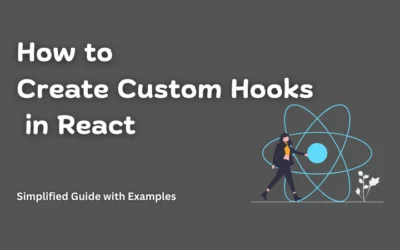React has emerged as one of the most popular JavaScript libraries for building user interfaces due to its efficiency, reusability, and simplicity. While React provides robust error handling mechanisms, it doesn’t always handle errors gracefully. Uncaught errors can lead to application crashes, leaving users with a frustrating experience.
To address this issue, React introduced Error Boundaries, a powerful feature that allows developers to gracefully handle and recover from errors. In this blog post, we’ll explore what Error Boundaries are, why they are useful, and provide some practical examples to demonstrate their effectiveness.
Contents
Understanding Error Boundaries
Error Boundaries are React components that catch errors during rendering, lifecycle methods, and in the constructors of their child components. They are a means of providing fallback UI and preventing the entire application from crashing when an error occurs. Error Boundaries work by using the componentDidCatch lifecycle method in class components or React hooks in functional components to intercept any errors thrown by their child components.
Why Are Error Boundaries Useful?
- Preventing Application Crashes: By enclosing parts of the application with Error Boundaries, developers can prevent the entire app from crashing when errors occur. Instead of showing a blank screen or a cryptic error message, a graceful fallback UI can be displayed to the user, informing them that something went wrong.
- Enhancing User Experience: Error Boundaries enable developers to handle errors more gracefully and provide users with informative feedback when something goes wrong. This helps to build trust with users and improves the overall user experience.
- Isolating Errors: Error Boundaries isolate errors to specific components, making it easier to identify and fix the problematic parts of the application. This isolation saves valuable debugging time by pinpointing the root cause of the error.
Implementing Error Boundaries
To create an Error Boundary in a functional component, you can use the useEffect and useState hooks. Here’s a basic example of an Error Boundary:
import React, { useState, useEffect } from 'react';
function ErrorBoundary({ children }) {
const [hasError, setHasError] = useState(false);
useEffect(() => {
if (hasError) {
// Log the error or send it to an error tracking service
console.error('Something went wrong.');
}
}, [hasError]);
const componentDidCatch = (error, errorInfo) => {
setHasError(true);
};
return hasError ? <h1>Something went wrong. Please try again later</h1> : children;
}
export default ErrorBoundary;
How to use the Error boundary
import React from 'react';
import ErrorBoundary from './ErrorBoundary';
function MyComponent() {
// Some code that might throw an error
if (someCondition) {
throw new Error('Oops! Something went wrong.');
}
return <div>My Component Content</div>;
}
function App() {
return (
<ErrorBoundary>
< MyComponent />
</ErrorBoundary>
);
}
In the example above, if MyComponent throws an error, the ErrorBoundary component will catch it and display the fallback UI instead of crashing the entire application.
Create Custom Hook useErrorBoundary
Custom hooks are a great way to encapsulate logic and share it across multiple components. Let’s create a custom hook called useErrorBoundary:
import { useState, useEffect } from 'react';
function useErrorBoundary() {
const [hasError, setHasError] = useState(false);
useEffect(() => {
if (hasError) {
// Log the error or send it to an error tracking service
console.error('Something went wrong.');
}
}, [hasError]);
const componentDidCatch = (error, errorInfo) => {
setHasError(true);
};
return { hasError, componentDidCatch };
}
export default useErrorBoundary;
Usage of the Custom Error Boundary Hook:
Now, you can use this custom hook in any component to create an error boundary:
import React from 'react';
import useErrorBoundary from './useErrorBoundary';
function MyComponent() {
// Some code that might throw an error
if (someCondition) {
throw new Error('Oops! Something went wrong.');
}
return <div>My Component Content</div>;
}
function ErrorFallback() {
return <h1>Something went wrong. Please try again later.</h1>;
}
function App() {
const { hasError, componentDidCatch } = useErrorBoundary();
return (
<>
{hasError ? <ErrorFallback /> : <MyComponent />}
</>
);
}
In this example, the useErrorBoundary custom hook encapsulates the error handling logic. The App component uses this hook to create an error boundary by checking the hasError value returned from the hook. If an error occurs within MyComponent, the ErrorFallback component will be displayed instead of crashing the entire application.
By creating custom hooks, you can reuse this error boundary logic throughout your application, making your code more organized and maintainable.
Best Practices for Using Error Boundaries
- Use Error Boundaries Sparingly: Error Boundaries should be used judiciously to wrap around critical components or areas of the application where errors are likely to occur. Overusing Error Boundaries may hide important bugs and hinder debugging efforts.
- Log and Report Errors: Inside the
useEffecthook, developers should log the error information to the console or send it to an error tracking service (e.g., Sentry or LogRocket). This way, you can monitor and fix issues proactively.
Conclusion
Error Boundaries are a valuable addition to the React ecosystem that empowers developers to create more robust and reliable applications.
By utilizing Error Boundaries strategically, you can prevent application crashes, improve user experience, and streamline the debugging process.
Remember to use them wisely and thoughtfully to enhance the stability and resilience of your React applications.
Happy coding!





0 Comments